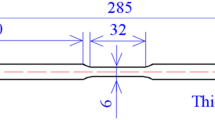Abstract
The ductility margins of a grade 5182 aluminum–magnesium alloy, which is traditionally used in the automotive industry, and a 1565ch aluminum–magnesium alloy having a higher magnesium content and microalloyed with zirconium are analyzed and compared. The mechanical properties, their anisotropy, and the microstructures of the alloys in the annealed state are studied, and forming limit and limiting stress diagrams are plotted. The stamping of a typical automobile-body part, namely, an inner hood panel, is simulated by the finite element method. The 1565ch alloy is found to have the ductility that is high enough for an automobile-body sheet: its ductility is comparable with that of the grade 5182 alloy and even slightly exceeds it in the uniaxial tension zone.








Similar content being viewed by others
Notes
To study the influence of zirconium on the strength properties, it would be better to choose an AMg6 alloy, the magnesium content in which is close to that in a 1565ch alloy. However, an AMg6 alloy has not been used and, apparently, will not be used for automobile-body sheets because of its low ductility. At the same time, a 1565ch alloy has good ductility for such a high magnesium content [19], which is likely to be caused by the fact that Al3Zr particles additionally refine subgrains and retard the motion of their boundaries during polygonization [23].
REFERENCES
D. V. Wilson, “Aluminium versus steel in the family car—the formability factor,” J. Mech.Work. Techn. 16 (3), 257–277 (1988).
J. Hirsch, “Aluminium in innovative lightweight car design,” Mater. Trans. 52 (5), 818–824 (2011).
Z. H. Jia, H. L. Huang, X. L. Wang, Y. Xing, and Q. Liu, “Hafnium in aluminum alloys: a review,” Acta Metall. Sinica (English Lett.) 29 (2), 105–119 (2016).
V. G. Davydov, V. I. Elagin, V. V. Zakharov, and L. D. Rostova, “Alloying aluminum alloys with scandium and zirconium additives,” Met. Sci. Heat Treat. 38 (8), 347–352 (1996).
V. V. Zakharov, “About alloying of aluminum alloys with transition metals,” Met. Sci. Heat Treat. 59 (1–2), 67–71 (2017).
F. Wang, D. Qiu, Z. L. Liu, and J. Taylor, “The grain refinement mechanism of cast aluminium by zirconium,” Acta Mater. 61 (12), 5636–5645 (2013).
J. Røyset and N. Ryum, “Scandium in aluminium alloys,” Int. Mater. Rev. 50 (1), 19–44 (2005).
J. Murray, A. Peruzzi, and J. P. Abriata, “The Al–Zr (aluminium–zirconium) system,” J. Phase Equilib. 13 (3), 277–291 (1992).
Y. B. Kang and A. D. Pelton, “Critical evaluation and thermodynamic optimization of the Al–Ce, Al–Y, Al‒Sc and Mg–Sc binary systems,” Calphad. 32 (2), 413–422 (2008).
B. Forbord, H. Hallem, and N. Ryum, “Precipitation and recrystallization in Al–Mn–Zr with and without Sc,” Mater. Sci. Eng., A 387, 936–939 (2004).
D. N. Seidman, E. A. Marquis, and D. C. Dunand, “Precipitation strengthening at ambient and elevated temperatures of heat-treatable Al (Sc) alloys,” Acta Mater. 50 (16), 4021–4035 (2002).
K. L. Kendig and D. B. Miracle, “Strengthening mechanisms of an Al–Mg–Sc–Zr alloy,” Acta Mater. 50 (16), 4165–4175 (2002).
V. Ocenasek and M. Slamova, “Resistance to recrystallization due to Sc and Zr addition to Al–Mg alloys,” Mater. Characteriz. 47 (2), 157–162 (2001).
W. Yang, D. Yan, and L. Rong, “The separation of recrystallization and precipitation processes in a cold-rolled Al–Mg–Sc solid solution,” Scr. Mater. 68 (8), 587–590 (2013).
K. Elkhodary, W. Lee, L. P. Sun, D. W. Brenner, and M. A. Zikry, “Deformation mechanisms of an Ω precipitate in a high-strength aluminum alloy subjected to high strain rates,” J. Mater. Res. 26 (4), 487–497 (2011).
K. I. Elkhodary and M. A. Zikry, “Dynamic crack nucleation, propagation, and interactions with crystalline secondary phases in aluminum alloys subjected to large deformations,” Philos. Mag. 92 (32), 3920–3949 (2012).
R. O. China, “Effects of precipitation behaviors on the microstructure and fracture toughness of Al–Cu–Mg aluminum alloys,” Optoelectronics Adv. Mater.–Rapid Communic. 10 (7, 8), 583–589 (2016).
L. S. Toropova, A. N. Kamardinkin, V. V. Kindzhibalo, and A. T. Tyvanchuk, “Investigation of alloys of the Al–Sc–Zr system in the aluminium-rich range,” Phys. Met. Metallogr. 70 (6), 106–110 (1990).
A. S. Oryshchenko, E. P. Osokin, N. N. Barakhtina, and A. M. Drits, “Aluminum–magnesium 1565ch alloy for cryogenic application,” Tsvetn. Met., No. 11, 84–90 (2012).
A. M. Drits, V. V. Ovchinnikov, and R. N. Rastopchin, “Properties of welded joints of the 1565ch alloy as applied to fabrication of welds,” Tsvetn. Met., No. 12, 85–90 (2012).
S. V. Rushchits, E. V. Aryshensky, and S. M. Sosedkov, “Modeling the hot deformation behavior of 1565ch aluminum alloy,” Key Eng. Mater. 684, 35–41 (2016).
S. V. Rushchits, E. V. Aryshenskii, and R. Kawalla, “Investigation of texture structure and mechanical properties evolution during hot deformation of 1565 aluminum alloy,” Mater. Sci. Forum 854, 73–78 (2016).
M. Cabibbo, S. Spigarelli, and E. Evangelista, “Microstructural characterization of secondary-phase particles in a hot-deformed Al–Cu–Mg–Zr alloy,” Metall. Mater. Trans. A 35 (1), 293–300 (2004).
O. Engler and J. Hirsch, “Polycrystal-plasticity simulation of six and eight ears in deep-drawn aluminum cups,” Mater. Sci. Eng. A 452, 640–651 (2007).
K. Velmanirajan, “Experimental investigation of forming limit, void coalescence and crystallographic textures of aluminum alloy 8011 sheet annealed at various temperatures,” Archives of Civil and Mechan. Eng. 14 (3), 398–416 (2014).
V. K. Barnwal, R. Raghavan, A. Tewari, K. Narasimhan, and S. K. Mishra, “Effect of microstructure and texture on forming behaviour of AA-6061 aluminium alloy sheet,” Mater. Sci. Eng., A 679, 56–65 (2017).
V. L. Kolmogorov, Mechanics of Metal Forming (Metallurgiya, Moscow, 1986).
Author information
Authors and Affiliations
Corresponding author
Additional information
Translated by K. Shakhlevich
Rights and permissions
About this article
Cite this article
Aryshenskii, E.V., Guk, S.V., Galiev, E.E. et al. Possibility of Application of a 1565ch Alloy in the Automotive Industry. Russ. Metall. 2018, 995–1001 (2018). https://doi.org/10.1134/S0036029518100026
Received:
Accepted:
Published:
Issue Date:
DOI: https://doi.org/10.1134/S0036029518100026




